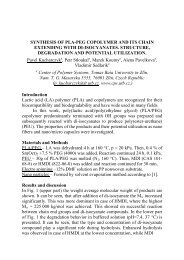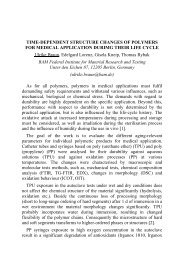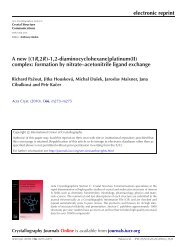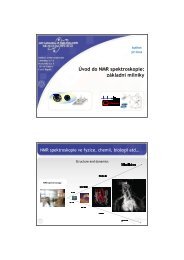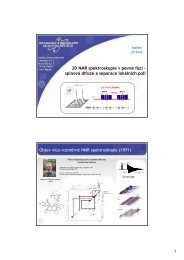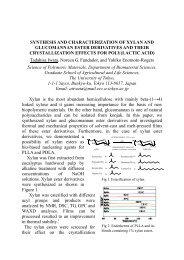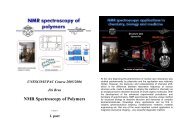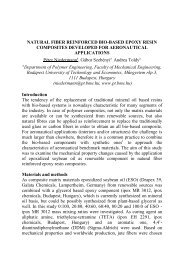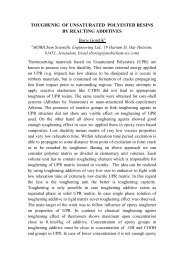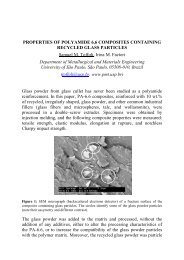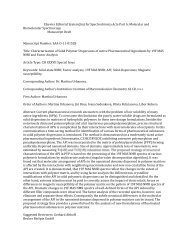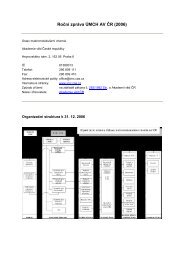polymery 2010 - Institute of Macromolecular Chemistry - Akademie ...
polymery 2010 - Institute of Macromolecular Chemistry - Akademie ...
polymery 2010 - Institute of Macromolecular Chemistry - Akademie ...
Create successful ePaper yourself
Turn your PDF publications into a flip-book with our unique Google optimized e-Paper software.
L-12<br />
EXTERNAL AND INTERNAL GELLING METHOD FOR PREPARATION OF<br />
PLANAR ALGINATE HYDROGELS<br />
E. Papajová a , M. Danko a , D. Chorvát Jr. a,b , Z. Kroneková a , I. Lacík a<br />
a Polymer <strong>Institute</strong> <strong>of</strong> the Slovak Academy <strong>of</strong> Sciences, Dúbravská cesta 9, 845 41<br />
Bratislava 45, Slovak Republic<br />
b<br />
International Laser Centre, Ilkovičova 3, 841 04 Bratislava 4, Slovak Republic<br />
e-mail: eva.papajova@savba.sk, igor.lacik@savba.sk<br />
Sodium alginate (SA) is a linear polysaccharide extracted from brown algae or bacteria. SA is<br />
composed <strong>of</strong> mannuronic (M) and guluronic (G) monomeric units arranged in homopolymer<br />
blocks or blocks <strong>of</strong> alternating M and G units. The structure <strong>of</strong> SA depends on the type <strong>of</strong><br />
source and tissue, age and growth conditions.<br />
Three-dimensional hydrogel networks are formed from SA in the presence <strong>of</strong> divalent cations<br />
(e.g. Ca 2+ or Ba 2+ ) [1]. The mild conditions <strong>of</strong> gelling process are advantageous for using SA<br />
hydrogels in the biology-oriented applications. Although vast information about the SA<br />
hydrogel formation for various applications exists, a further work is needed toward the<br />
flexibility in shape variability (beads, thin layers, thicker slabs, fibres, rods etc).<br />
Nowadays, two basic principles are known for SA hydrogel preparation, i.e. internal [2] and<br />
external [1] gelling methods. Internal gelation is based on dissolving <strong>of</strong> CaCO3 particles (as a<br />
source <strong>of</strong> Ca 2+ ions) dispersed in SA solution upon lowering the pH value. This type <strong>of</strong><br />
gelation is most <strong>of</strong>ten used for preparation <strong>of</strong> SA hydrogels <strong>of</strong> planar, cylindrical and<br />
spherical geometries. An external gelling is based on diffusion <strong>of</strong> dissociated divalent cations<br />
from external environment into the SA solution. The gelling process begins immediately after<br />
the mutual exposure <strong>of</strong> these two phases. In this case, a bead is the most typical geometry.<br />
The external gelling is not common for formation <strong>of</strong> SA hydrogels <strong>of</strong> planar geometry due to<br />
the fact that fast exposure <strong>of</strong> SA solution by solution <strong>of</strong> divalent cations results in an<br />
uncontrolled shape distortion.<br />
This contribution deals with preparation <strong>of</strong> planar hydrogels by external gelling method. The<br />
external gelling in formation <strong>of</strong> planar SA hydrogels introduces advantages over the internal<br />
gelling process represented by physiological pH and the absence <strong>of</strong> CaCO3 particles not<br />
always completely disappearing after the gelling. The main idea <strong>of</strong> planar hydrogel<br />
44



